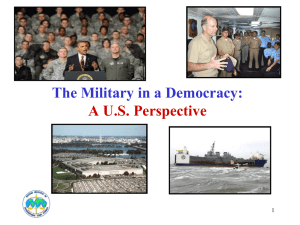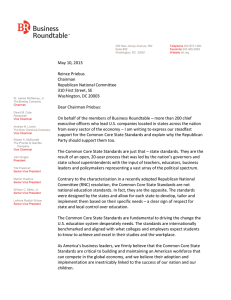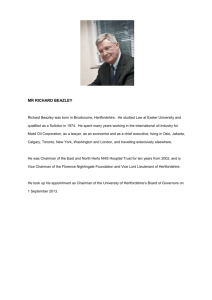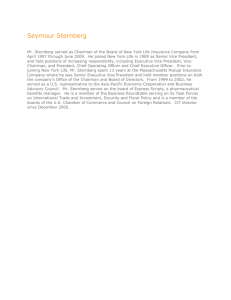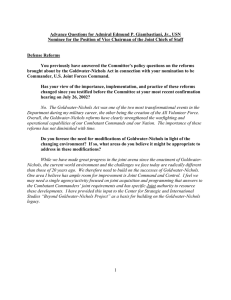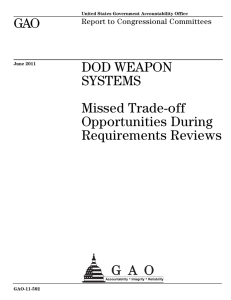Advance Questions for General Peter Pace, USMC
advertisement
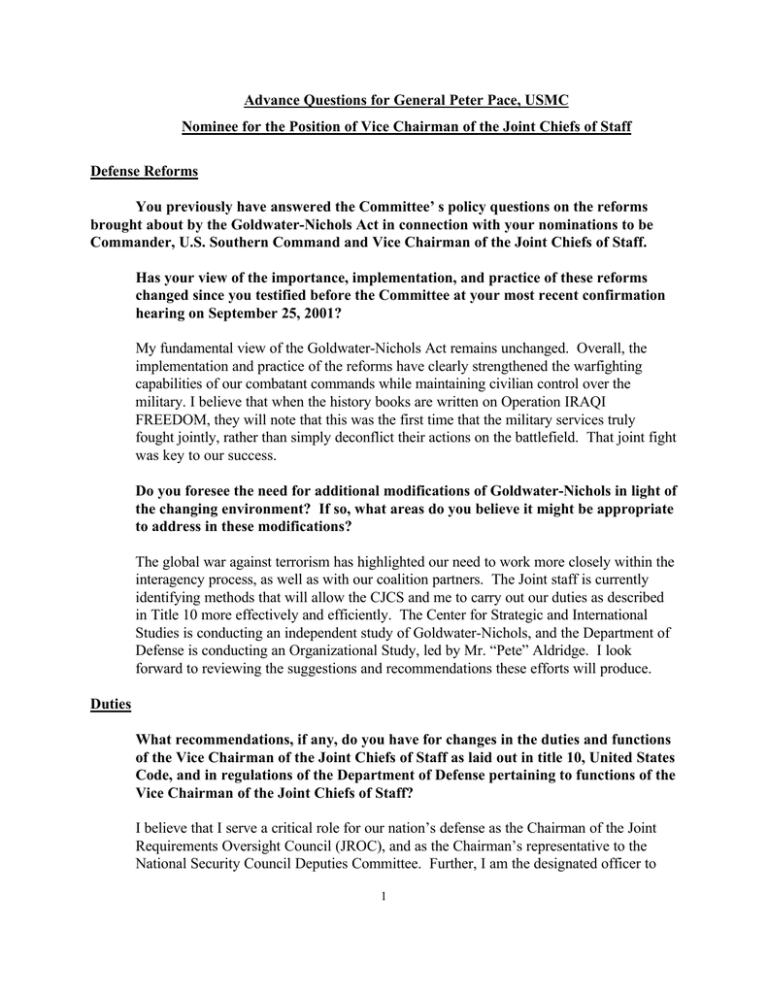
Advance Questions for General Peter Pace, USMC Nominee for the Position of Vice Chairman of the Joint Chiefs of Staff Defense Reforms You previously have answered the Committee’ s policy questions on the reforms brought about by the Goldwater-Nichols Act in connection with your nominations to be Commander, U.S. Southern Command and Vice Chairman of the Joint Chiefs of Staff. Has your view of the importance, implementation, and practice of these reforms changed since you testified before the Committee at your most recent confirmation hearing on September 25, 2001? My fundamental view of the Goldwater-Nichols Act remains unchanged. Overall, the implementation and practice of the reforms have clearly strengthened the warfighting capabilities of our combatant commands while maintaining civilian control over the military. I believe that when the history books are written on Operation IRAQI FREEDOM, they will note that this was the first time that the military services truly fought jointly, rather than simply deconflict their actions on the battlefield. That joint fight was key to our success. Do you foresee the need for additional modifications of Goldwater-Nichols in light of the changing environment? If so, what areas do you believe it might be appropriate to address in these modifications? The global war against terrorism has highlighted our need to work more closely within the interagency process, as well as with our coalition partners. The Joint staff is currently identifying methods that will allow the CJCS and me to carry out our duties as described in Title 10 more effectively and efficiently. The Center for Strategic and International Studies is conducting an independent study of Goldwater-Nichols, and the Department of Defense is conducting an Organizational Study, led by Mr. “Pete” Aldridge. I look forward to reviewing the suggestions and recommendations these efforts will produce. Duties What recommendations, if any, do you have for changes in the duties and functions of the Vice Chairman of the Joint Chiefs of Staff as laid out in title 10, United States Code, and in regulations of the Department of Defense pertaining to functions of the Vice Chairman of the Joint Chiefs of Staff? I believe that I serve a critical role for our nation’s defense as the Chairman of the Joint Requirements Oversight Council (JROC), and as the Chairman’s representative to the National Security Council Deputies Committee. Further, I am the designated officer to 1 perform the duties of the Chairman should he be absent or unable to perform his duties as established by Title 10. In all of these functions, it is both my legal responsibility and moral obligation to provide my best military advice to the President, the Secretary of Defense, and the National Security Council. The Goldwater-Nichols Act has provided the appropriate language to create my position. I advocate keeping the position and duties of Vice Chairman of the Joint Chiefs of Staff in tact. Vice Chairman’ s Term of Office Requirements for appointment as Vice Chairman of the Joint Chiefs of Staff and limitations on the length of time an officer may serve in that capacity, including renewable two year terms under certain conditions, are set forth in section 154 of title 10, United States Code. What are your personal views about the sufficiency of the provisions of existing law regarding the office of Vice Chairman of the Joint Chiefs of Staff as set forth in section 154? Recently, the Department of Defense proposed legislation to provide for 2 year terms for both the CJCS and the VCJCS and that the President could reappoint the CJCS and the VCJCS as he deems necessary. The current limitation of two additional terms would be removed under this proposal. I support this proposal as it provides the President increased flexibility in managing the most senior levels of his military advisors, and takes greater advantage of the military expertise and experience accumulated during previous terms. Relationships Please identify any changes you have observed since your last confirmation in the relationships between the Vice Chairman of the Joint Chiefs of Staff and the following officials. The Deputy Secretary of Defense. Under existing directives, the Deputy Secretary of Defense has been delegated full power and authority to act for the Secretary of Defense on any matters that the Secretary is authorized to act. Because of our close association and coordination in numerous briefings, particularly those involving the Global War on Terrorism, I am proud to report that the relationship between the Vice Chairman and the Deputy Secretary of Defense has grown even stronger over these past two years. 2 The Under Secretaries of Defense. TitIe 10, United States Code, and current DoD directives establish the Under Secretaries of Defense as the principal staff assistants and advisors to the Secretary regarding matters related to their functional areas. Recently, the Secretary established the Under Secretary of Defense for Intelligence. Aside from this new position, I have not noticed any changes in the relationship of the Vice Chairman of the Joint Chiefs of Staff with the Under Secretaries of Defense since my last confirmation hearing. The Assistant Secretaries of Defense. The Secretary of Defense has created a new Assistant Secretary for Networks & Information Integration who reports directly to the Deputy Secretary of Defense. He has also created a new ASD for Homeland Defense who reports to USD (Policy). Aside from these new positions, I have not noticed any changes in the relationship of the Vice Chairman of the Joint Chiefs of Staff with the Assistant Secretaries of Defense since my last confirmation hearing. The Chairman of the Joint Chiefs of Staff. I have great respect and admiration for General Myers and the job he has done as Chairman of the Joint Chiefs of Staff. I am proud to serve as his Vice Chairman, and we enjoy a close, and closely coordinated relationship, not only between our offices, but between us and the Secretary and Deputy Secretary of Defense. This represents a continuation of the very effective relationship between the Chairman of the Joint Chiefs of Staff and the Vice Chairman of the Joint Chiefs of Staff since my last confirmation hearing. The Secretaries of the Military Departments. The Undersecretary of the Air Force now acts as the Executive Agent for Space Program procurement, which is especially important to the Vice Chairman in the Vice Chairman’s role as Chairman of the JROC. Aside from this, I have not noticed any changes in the relationship of the Vice Chairman of the Joint Chiefs of Staff with the Secretaries of the Military Departments since my last confirmation hearing. The Chiefs of Staff of the Services. I have not noticed any changes in the relationship of the Vice Chairman of the Joint Chiefs of Staff and the Chiefs of Staff of the Services since my last confirmation hearing. The Combatant Commanders. 3 The President-approved Unified Command Plan created US Northern Command and redefined the roles and responsibilities of US Strategic Command. Both of these new command entities have enhanced the overall ability of the Armed Forces and the Department of Defense. Aside from these welcomed additions, I have not noticed any changes in the relationship of the Vice Chairman of the Joint Chiefs of Staff with the Combatant Commanders since my last confirmation hearing. Major Challenges and Problems In your view, what are the major challenges that you would confront if confirmed for a second term of office as Vice Chairman of the Joint Chiefs of Staff? In my view, there are two major challenges. First, there is the challenge of maintaining the extent and breadth of our current commitments while being prepared to respond to others. Simultaneously, we have the challenge of transforming our Armed Forces to become a force well positioned to face the demands of the twenty-first century. The United States is well positioned to meet these challenges. We must continue our warfighting efforts; transform the force in a way that makes joint warfighting second nature; and streamline the strategic landscape. Assuming you are confirmed, what plans do you have for addressing these challenges? The Joint Staff has a long history of anticipating, planning and executing plans that address these issues. Over the past year we have undertaken an Operational Availability Study to assess our force needs and deployment timelines in the context of our military strategy. As we look forward, we will continue to execute seminar war games in support of our global commitments, such as Prominent Hammer and Elaborate Crossbow. These and other efforts clearly have shaped our current operational thinking and planning as we work with the Combatant Commanders to prepare for the future. We are also using Operation IRAQI FREEDOM as an opportunity to evaluate basing opportunities against the backdrop of the new strategic situation. The Services are also reviewing their rotation policies to optimize their readiness and ability to respond globally. All of these efforts are being done through the lens of our new strategy. We will continue to capitalize on our lessons learned from recent operations. We must also continue on the road to Transformation. Over time, we will use our 4 recently implemented capabilities-based methodology, to establish a common baseline for analyzing future capabilities and identifying and filling capability gaps. Transformation If confirmed, you would continue to play an important role in the process of transforming the Armed Forces to meet new and emerging threats. With the benefit of almost two years in office, please discuss the progress that the Department has made in transforming the Armed Forces? One area of transformational progress that I am particularly proud of as the Chairman of the JROC is the Operational Availability Study. Simply put, this has been an iterative process of asking ourselves and our combatant commanders how much of our warfighting capability is needed, and how quickly is it needed at a particular place to support the various war plans. By reviewing the plans in this way, we have been able to tee up decision points for the Secretary of Defense that have transformed the way we plan, preposition, and mobilize our current force. It also will have significant impact on how we equip our forces for future joint warfighting requirements. What are your goals regarding transformation in the future? I believe that transformation is as much a mind set as it is the acquisition of new equipment or the implementation of new doctrine. My goal is to help grow a generation of warfighters who are both firmly established in their service culture and strengths, and equally as comfortable applying that knowledge in the joint arena. The approach to future transformation should incorporate the latest technological capabilities, but should also include the ability to think differently about what we already have. Joint Officer Management Provisions of law in title 10, United States Code, regarding such matters as management policies for joint specialty officers, promotion objectives for joint officers, joint professional military education, and joint duty assignments have been in effect for over 15 years. Among other factors, changes in the size and composition of the officer corps, in the career patterns of officers, in operational requirements, and in the personnel requirements of the combatant commanders in successfully pursuing joint warfare have resulted in proposed legislative changes to existing law. Based on your extensive experience in the joint arena, what legislative changes, if 5 any, would you recommend in joint officer management and joint professional military education? While the intent of JOM portion of the Goldwater-Nichols Act remains valid, the requirement for JSOs has changed as the Department has gained experience in joint operations. The combatant commanders tell us they need officers well grounded in their functional skills and Service competencies, not simply joint specialists. We believe the combatant commanders are in the best position to identify their JSO requirements, and the current numerical JSO quotas limit their desired flexibility. In Mar 2003, the Department forwarded the report of the congressionally directed Independent Study of Joint Officer Management and Joint Professional Military Education. The completed report made several recommendations regarding changes needed to update JOM/JPME. We are developing a strategic plan to help shape JOM to meet our future joint requirements. What legislative changes, if any, regarding the management of general and flag officers would you recommend? The general and flag officer (G/FO) management changes delineated in the Defense Transformational Act of 2003 will improve the efficiency and effectiveness of the Department of Defense. The Department’s goal is to design a transformational G/FO management system that provides flexibility to the President, the Secretary of Defense, and the Military Departments in order to respond to rapidly changing situations. The enhanced ability to manage G/FO job tenure and career length will improve responsiveness to the evolving requirements of the 21st Century and continue to attract, develop, and retain talented, experienced general and flag officers. Joint Requirements With the establishment of U.S. Joint Forces Command, it was envisioned that the Commander, U.S. Joint Forces Command, would represent the requirements and interests of combatant commander in the overall defense requirements and acquisition process. In your view, has the Commander, U.S. Joint Forces Command, been able to satisfactorily represent the requirements and needs of combatant commanders to the Joint Requirements Oversight Council and the military services? Yes. For example, in June of this year the Chairman issued the Joint Capabilities Integration and Development System (JCIDS) Instruction, CJCSI 3170.01C. JCIDS enumerates the procedures of the Joint Requirements Oversight Council (JROC). The JROC supports the Department by identifying, assessing and prioritizing joint military capability needs. JCIDS moves the JROC from a requirements-based to a capabilities6 based process – a change specifically designed to better develop up-front integrated joint warfighting capability for the Combatant Commanders, and specifically enabling the interaction you envision for Joint Forces Command. In particular, under JCIDs, Commander, Joint Forces Command, leads the Command and Control Functional Capabilities Board (FCB), which is the principal organ for representing the joint and interoperable qualities so essential for effective command and control in the future. Are combatant commanders able to identify critical joint warfighting requirements and quickly acquire needed capabilities? Combatant Commanders identify joint warfighting requirements well. The new JCIDS process improves their participation and strengthens their voices in moving requirements forward and developing solutions. Every Functional Capabilities Board (FCB) includes expanded Combatant Commander representation, giving them improved insight and new leverage. Advanced Capabilities Technology Demonstration (ACTD), is one of the Department’s means of testing and quickly fielding promising systems. This new process strengthens and empowers the Combatant Commanders in quickly fielding solutions to their warfighting needs. What suggestions, if any, do you have for improving the requirements and acquisition process to ensure that combatant commanders are able to quickly acquire needed joint warfighting capabilities? In addition to ACTDs, the Department has a number of other methods for quickly fielding our best ideas, including the Joint Test and Evaluation Program that is used to assess the military utility of new capabilities and mature advanced technologies. This program, initiated at the Congress’ behest, employed and evaluated 11 initiatives in Operation IRAQI FREEDOM. My suggestion for improving the process would simply be to continue the course with these new methods of fielding our new ideas and promising systems. Defense Planning The Office of the Secretary of Defense recently announced the overhaul of the Planning, Programming, and Budgeting System and adopted a two-year planning cycle. The Planning, Programming, Budgeting and Execution (PPBE) system will “...get more integrity into the whole system, much more efficiency, much more clarity, and much more credibility,” according to the Comptroller. What do you see as the Joint Staff’ s role in this new system? 7 The Joint Staff’s role is unchanged. The Chairman will continue to meet his statutory obligations by issuing Program Appraisal and Program Recommendation memoranda and participating actively in development of the Defense Planning Guidance and in annual OSD program and budget reviews. Will the new Planning, Programming, and Budgeting and Execution (PPBE) system be more responsive to the requirements of the combatant commanders than the old system? Yes. The new Joint Capabilities Integration and Development System (JCIDS) supports the Defense Department’s aim of providing equipment that is used throughout each of America’s armed services and that best meets the needs of the Combatant Commanders. The new JCIDS process directly feeds the PPBE, serving as a tool for Combatant Commanders to make timely inputs to the PPBE system for follow-on programmatic actions. JCIDS not only better incorporates the Combatant Commanders capability concerns early in the process, it also helps combine these needs with the joint concepts and architectures they have already identified. Additionally, it provides them a seat on the Functional Capabilities Board that reviews issues in a joint manner across the Department. Do you believe the Joint Forces Command should have a more active role in the PPBE? If so, how should they be included in the process? If not, why not? The Commander, U.S. Joint Forces Command, Admiral Giambastiani, has aggressively set about accomplishing the broadened mission he was given under change two to the Unified Command Plan. He has reinvigorated Joint Forces Command’s ties to the planning, programming, budgeting, and execution functionaries in Washington, and as such is playing a very active role in PPBE. Joint Requirements Oversight Council (JROC) In your response to the Committee’ s advanced policy questions from your last confirmation, you indicated an intent to strengthen the JROC’ s strategic focus with the goals of enhancing the JROC’ s influence of requirements integration through the development of operational concepts and architectures; integrating U.S. Joint Forces Command joint experimentation efforts into the JROC process; and shifting the JROC’ s focus to future joint warfighting requirements while still addressing current CINC priorities. How would you assess your success to date in achieving these goals? 8 We are on the right path and have recently taken several steps to ensure the JROC process is better focused on capabilities needs -- a top down, strategy based approach. A lot of work has gone into this already and more remains to be done. We are developing a Joint Operations Concept to provide an overarching linkage between strategy and capabilities. The Combatant Commanders are providing four underpinning Joint Operating Concepts. We have aligned our Joint Warfighting Capability Assessment Teams into five functional areas - each of which will have its own associated functional concept. Finally, we have laid out a plan for reviewing and refining these concepts as the Combatant Commanders and Functional Concept teams bring them forward. Has your vision for the role and priorities of the JROC changed since 2001? The requirements generation process needed to change. The old requirements generation process too-often produced stove-piped solutions that were platform-centric and overly threat-based. We found we needed to provide betters tools, to allow for more objective analysis. The recently approved Joint Capabilities Integration and Development System (JCIDS) process addresses these shortcomings. JCIDS transforms requirements generation from a threat and system-based requirement process to a capability-based process, and provides a more focused and complete functional needs analysis to JROC decision-makers. Are you satisfied that the requirements process has been applied appropriately to missile defense programs? I am satisfied that the requirements process has been applied appropriately to missile defense programs. The Unified Command Plan 02, Change 2 Terms of Reference designates U.S. Strategic Command as the advocate for all combatant commanders' desired missile defense and missile warning characteristics and capabilities. Admiral Ellis, Commander of Strategic Command, is executing that responsibility in coordination with the Chairman of the Joint Chiefs and the Joint Requirements Oversight Council (JROC). This complies with recent Congressional changes mandating that the Joint Requirements Oversight Council (JROC) review MDA programs. How do you see the role of the JROC evolving as the Department moves toward spiral development and a capabilities based acquisition system? We feel we now have the process about right with the implementation of the new Joint Capabilities Integration and Development System (JCIDS). A specific feature of JCIDS is to avoid making capabilities needs determination a “100 percent” solution at the start, and to take advantage of the beneficial flexibility of spiral development. Reliance on Reserve Component 9 The men and women of the Reserve component have performed superbly in meeting the diverse challenge of the global war on terrorism. There is uncertainty, however, about the potential adverse effects on recruiting, retention, and morale of continuing mobilization of Guard and Reserve personnel. What is your assessment of the impact of continuing Guard and Reserve deployments on the readiness and attractiveness of service in the Guard and Reserve? The prolonged demand on the Guard and Reserve is a very serious concern, and we are working hard to deal with this issue. The Reserve Component continues to perform exceptionally well and has proven to be a major contributor to our force structure. To maintain current levels of responsiveness, we must continue to ensure our personnel receive strong support from their civilian employers and their families. We are evaluating several measures that will reduce the strain on the Guard and Reserve forces while continuing to maintain responsiveness and flexibility. What missions do you consider appropriate for permanent assignment to the Reserve component? Although there are unique functions performed specifically by the Reserve Compoment, the majority of Guard and Reserve members participate and provide support across the spectrum as an integral part of the total force. We are conducting studies to look at realigning Active and Reserve component capabilities to better match the defense strategy. Specifically, we are reviewing a wide range of capabilities including those that predominantly reside in the Reserve Component, from capabilities currently in highdemand for on-going operations, to those that are not frequently mobilized. We are also studying the capabilities required for homeland security, and those that are critical to posthostilities operations. End Strength of Active Duty Forces In light of the manpower demands of Operation Iraqi Freedom, do you consider the level of active duty authorized end strength proposed in the FY 2004 budget to be sufficient for today’ s missions? Yes. We can be justifiably proud of the actions of both active duty and reserve component personnel who have successfully accomplished their assigned missions during Operations IRAQI FREEDOM, ENDURING FREEDOM, and NOBLE EAGLE. The President’s partial mobilization of the Reserve Components has allowed us to meet a short-term spike in requirements for security forces, intelligence, and communications skills. I truly believe in the Total Force concept. These specific requirements, while not 10 indefinite, will likely continue in the near term to support homeland defense, antiterrorism, and force protection. I believe the long-term solution is not increasing the authorized end strength, but rather looking at the current force mix, and realigning to meet the anticipated needs of the future. How do you assess the progress made to date by the Services in finding ways to reduce the numbers of military personnel performing support functions that can better be performed by civilian employees or contractors? I believe the Services are making great strides in identify functions requiring military skills, and those that could be performed by civilian employees or contractors. This is an ongoing effort, with an initial review of more than 300,000 military billets being considered for conversion. To date, close to 50,000 military billets have been identified for conversion, but we expect this number to increase as we continue the review. What manpower savings can be achieved through reductions in overseas presence, application of technology, and changes in roles and missions? We are taking a comprehensive look at missions, technology, basing, and required force structure to determine the optimal location of our military forces to meet any challenge. As these reviews are currently in their early stages, we do not have any projections on manpower savings. Congressional Oversight In order to exercise its legislative and oversight responsibilities, it is important that this Committee and other appropriate committees of the Congress are able to receive testimony, briefings, and other communications of information. Do you agree, if confirmed for this high position, to appear before this Committee and other appropriate committees of the Congress? Yes Do you agree, when asked, to give your personal views, even if those views differ from the administration in power? Yes Do you agree, if confirmed, to appear before this Committee, or designated 11 members of this Committee, and provide information, subject to appropriate and necessary security protection, with respect to your responsibilities as the Vice Chairman of the Joint Chiefs of Staff? Yes Do you agree to ensure that testimony, briefings and other communications of information are provided to this Committee and its staff and other appropriate Committees? Yes 12
